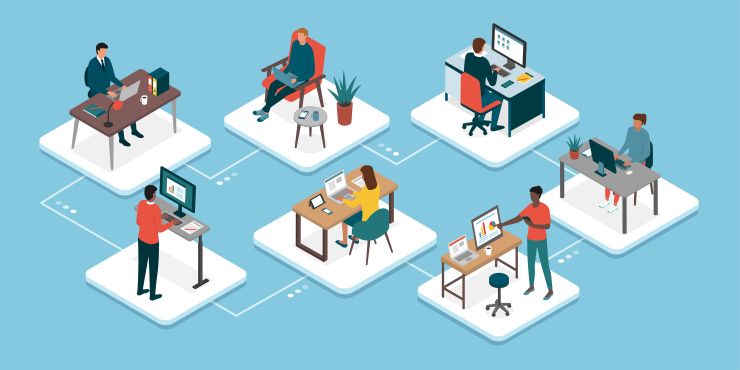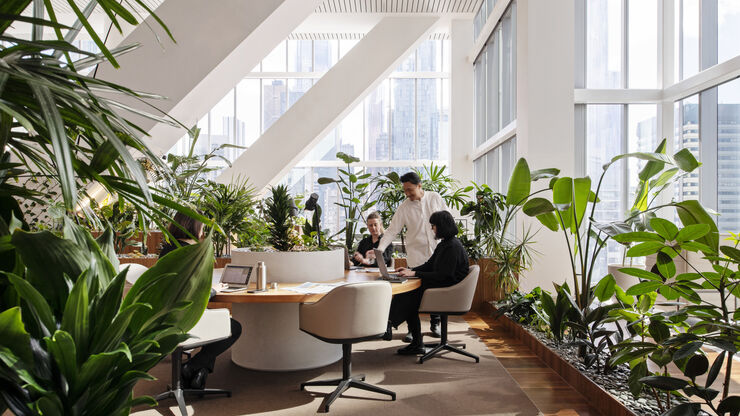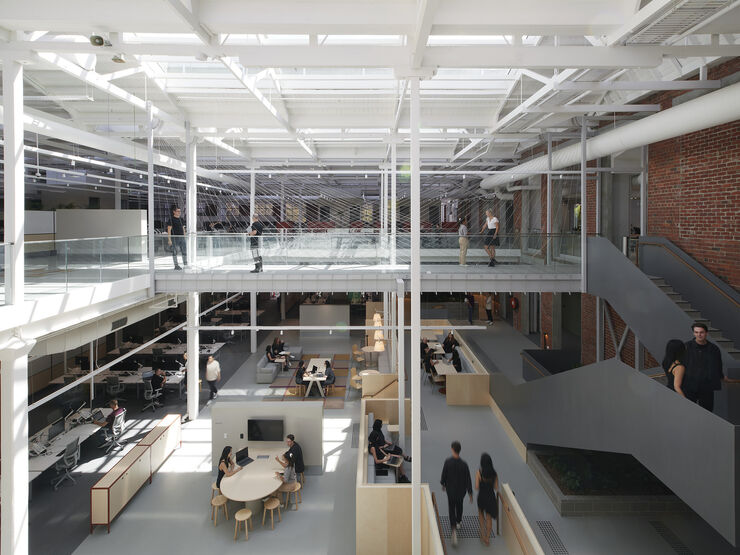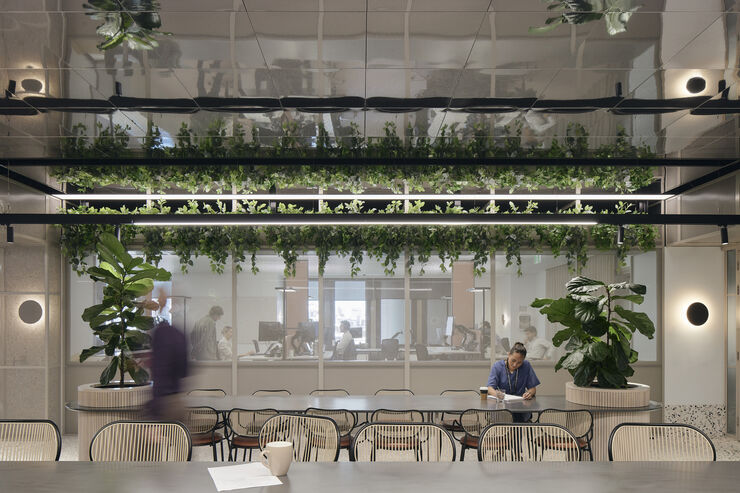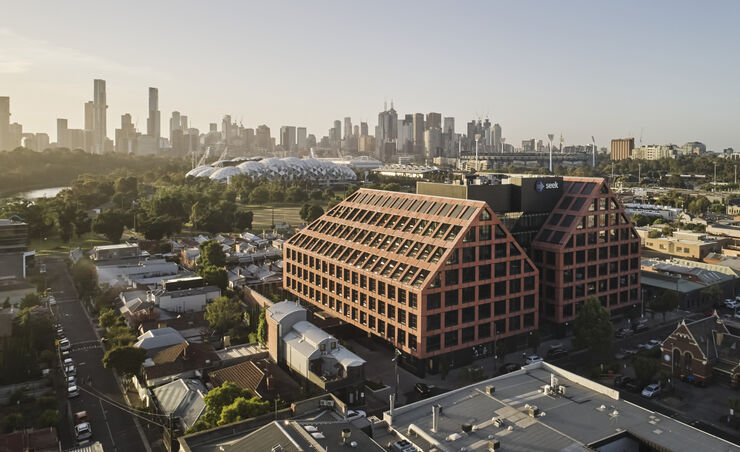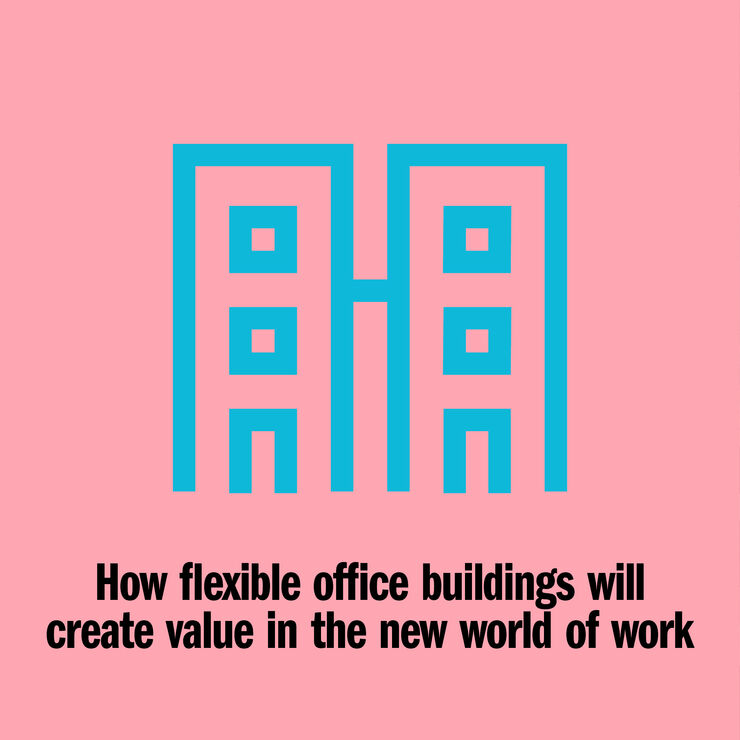Transcript
Domino Risch:
From international design firm, Hassell, this is Hassell Talks. Hi, I’m Domino Risch. I’m a designer, and commercial and workplace sector leader at Hassell. I love creating workplaces that connect organisational culture and performance that bring joy and inclusivity to all that use them, and make us happier and healthier when we experience them. Imagine that. The last two years have brought a particular scrutiny to the very purpose of workplaces for all organisations. And it doesn’t matter whether they’re workplaces for tech firms, finance, professional services, legal, all sectors are sure that the one thing we need to focus on is how to get the most value out of space. How to get people back in, and how to make sure that culture stays strong, connections are reinforced, and that their people are thriving.
At Hassell, we’re also thinking about this. Since early 2020, we’ve been focusing on building up a body of data from our annual workplace survey, which informs clients and our own design teams actually, about what people are looking for in returning to work. And it guides us during this incredible time of change for employers and employees alike. This year, the 2022 survey is bigger and better than ever, and this time it includes insight from China. It also reinforces the approach to hybrid working, the role of flexibility in retention and cultural development. And surprisingly, the role of home in a workplace. With me today is our survey author and senior researcher, and all round great guy Daniel Davis. Hi Daniel.
Daniel Davis:
Hey there, Domino. Good to see you.
Domino Risch:
Good to see you too. You’ve been in the thick of it, and you know this data inside out and back the front, so tell us a little bit about what was different in the way you approached this year’s survey to the other years.
Daniel Davis:
It’s the third year that we’ve run the workplace survey, and when the pandemic was just kicking off in 2020, and we were running a survey back then, we were really interested in just how people were doing, and what was happening in Australia at that time. The next time that we ran it in 2021, we became more interested in what was going on globally, and how people were doing in these different regions. And then, this year really when we ran the survey, the question that we were asking, it wasn’t so much focused necessarily on where people were, and what was happening. Although we were interested in that, we were really trying to get into why things were the way they were, and why people wanted to work in the places they worked. The other difference this year is that we included China. This year we surveyed in Australia, Singapore, China, the US and the UK. And it gives a really good feel for what’s happening around the world because all those countries are culturally quite different, and there’s interesting things happening in each one of them.
Domino Risch:
So Daniel, this year is the first time the survey has been run in China. Can you talk a little bit about how that was done in terms of the mechanics of it, but also any of the things that needed to be different to include China?
Daniel Davis:
Yeah. China’s one of the most challenging places to survey just given the regulations and stuff over there. The way that we survey all the other countries is that we work with a third-party provider, and they go and find all these people to answer the survey for us. We tell them that we want to survey office workers, and that we want a representation sample of people between these ages, and that work in these industries. And they go and find people that fit that description, and get them to take the survey on our behalf. And we work with them as well in China to do this. One of the biggest challenges that we had is that China actually blocks a lot of apps that do surveys. They don’t want people, particularly from America or Australia going over there, and surveying their population, and finding things out. They’re very controlling over how that happens, and to the extent that for some surveys, you need a government licence basically, to send out a survey.
We ended up having to translate the survey into another software to get it done, and work with another provider over there to actually even host the survey. And then, we also had to translate it into Chinese so that it’s obviously understandable for people over there. It was a lot of work to get it done in China, but I’m really happy that we were able to do that. It’s such an interesting market when it comes to the workplace. There’s obviously a lot of different projects going on there. There’s a lot of companies from outside China, that are coming into China, and there’s a real mixing of different ways of thinking about the workplace happening in that country, and it’s really interesting to see what’s happening there.
Domino Risch:
Yeah. Even the language that we use, the word lockdown isn’t used in China. Even talking about the shared COVID experience globally, we need different language, right?
Daniel Davis:
Yeah, and when we ran the survey it was March and April of 2022, and it’s just at the start of China having a large COVID outbreak in the country. I think part of what’s going on there is just the experience of COVID’s been really different for people over there. They haven’t necessarily had the same danger, or the experience of danger that people in places like America might have had, but at the same time, they’ve had these government regulations that have controlled a lot of how people behave. It’s just a different way of experiencing that, and maybe some of the things that we experienced in the States like two years ago, they’re beginning to experience that same thing over there now.
Domino Risch:
What’s new in the actual data and the preferences? Can you share some of the really key findings that we’ve discovered?
Daniel Davis:
There were six insights that we found, and today, I’m just going to focus on three of them. The thing that jumped out at me the most when I was doing the analysis was the role of the office in terms of people’s engagement. In the survey itself, we asked people a series of questions about how engaged they were at work, how much they trusted their colleagues, and other things related to that. And those were scientific questions that researchers had established in scientific papers, and we asked those questions in the same way. We had these benchmark ways of measuring engagement. Also, in the survey, we asked people how much time they spent in an office, and how much time they spent at home. And we had a series of questions that teased it out because it’s actually quite complex working out where people were working. And what was interesting is that when we took those two data sets and we combined them together, is that there was this real relationship between them. That people that worked at home 100% of their time, their engagement, it might have been around like 60% or 70%.
But you saw on the graph that as people spent longer and longer, or did more and more of their work in the office, their engagement tended to increase, their trust in colleagues tended to increase. But you also saw at the very end of those graphs, that people that spent 100% of their time in the office actually weren’t doing too well in terms of things like engagement and trust. And there was this real sweet spot of people that were in the office, maybe 60% or 80% of their work week. They weren’t there full-time. Sort of doing this hybrid mode of working who tended to be the most engaged people in the survey, the most trusting of their colleagues, and all these important outcomes that we measure in terms of things that ultimately lead to productivity, and retention in the workforce.
Domino Risch:
And Daniel, do you think from that, we can also infer that perhaps given there’s a lot of survey data out there at the moment that says almost nobody elects to be at work five days a week anymore, that the people who are there five days a week maybe haven’t got choice in that, and that’s what’s striving that difficulty in feeling connection, and being trusted by the organisation?
Daniel Davis:
Yeah, there’s definitely something odd going on with the people that are there like five days a week.
Domino Risch:
Yeah, that’s odd, right?
Daniel Davis:
Yeah, no, it is. Even before the pandemic it was common for people to do work in the office, but also to work at home. And we maybe didn’t think of that as hybrid working in the way that we think of it now, but it was a form of hybrid working. And there’s people that are in the office doing 100% of their work there. There’s something about the way that they experience that that isn’t positive. And the thing that I think really draws that out is we asked people about their workplace policy and we asked them, are you required to come into the office? Are you allowed to work in this hybrid manner? Are you working at home completely?
And what we saw there is that people that were required to be in the office full-time were about twice as likely to be thinking about resigning as people that had some degree of flexibility. And this is well known in workplace research, but people that are given autonomy and flexibility, they tend to be happier in what they’re doing because they have some choice in it. And we see that when you take away that choice, people tend to have these negative outcomes, and you also see it in the other directions as well. People that are forced to work at home, and don’t have the option of working in another place, they often are more likely to be thinking about resigning than the people in the middle there that have this choice about whether they’re working at home, or the office, and can change that choice throughout the week.
Domino Risch:
It sort of leads us to conclude I guess that policies, procedures, and protocols that organisations are wrapping around flexible work have a massive contributing factor to the culture that ultimately they end up with. That’s such a key finding, isn’t it?
Daniel Davis:
Yeah, absolutely. And I think some of these organisations are potentially getting themselves into a bit of a tricky spot. We’re seeing companies coming out very strongly one way or the other in terms of working from home, or working from the office, and pushing employees in a particular direction. And I think long term, that’s not a positive thing for their cultures.
Domino Risch:
When people are electing to come to the office, I suppose, Daniel, from the data, what is it that they’re looking for do you think? What is it that’s attracting them back? Or that they’re seeking that they’re not getting in working from home? Obviously, beyond their interpersonal and face-to-face and social elements.
Daniel Davis:
We ask people what it was that they wanted to see from the workplace when they returned, and we gave them a list of items, and we asked them which ones of these would you most like to see in your office when you return? Or if you’re there currently, what would you like to see? And the first one, or the most popular option, was free food and lunch. And that’s something that’s come up-
Domino Risch:
Of course.
Daniel Davis:
Yeah, it always comes up in our surveys. It is funny, but it’s also serious in some ways because I think you think of free food and lunch, you’re like, ah, it’s just like someone wants to have a $10 lunch or whatever given by the company. But I think more than that, it’s that they want to connect with their colleagues, and spend time with one another, and to socialise with people.
Domino Risch:
I’ve been thinking a lot about this data point because it’s come up in all three surveys as if not, one of, but the actual highest thing on the list of things that people would like in returning to work. My theory is similar to yours, Daniel, in that we’re human creatures. We’ve evolved over millennia to be stronger in groups, and whether that’s family units or tribes or small cities and towns, through much of history. And when we’re forced to live alone, or just to retreat to our nuclear families through lockdowns and so on, what we miss is that sense of being together, breaking bread, sharing a meal. That’s traditionally how people would choose to come together in a work environment. That’s obviously less traditional unless you live in Scandinavia, and you have a cafeteria lunch, which is quite common over there together as a group. And I think that’s driving this desire for the food at work because it’s a metaphor I think, or a vehicle for reconnecting with people. I don’t think it’s so much about the food, I think it’s the activity of food that’s putting that so high on the list.
Daniel Davis:
I’ve read recently that the word company, the origin of that word like pan is bread, and it means sort of coming together to break bread essentially as a group, which think’s interesting in that sense. The next most popular things that we saw this year were fresh air from outside, and gardens and green space. And I’m not sure if that’s something you’ve been hearing from your clients, Domino, but I think it makes sense to me that we’ve been spending so much time inside, that people want to have connection to the outside. I also think that there’s this thing going on where we associate the outside with being safe at the moment, and inside with some element of danger. I think there’s something going on there that’s important.
Domino Risch:
A hundred percent. I think our survey doesn’t really ask a whole lot of questions about how people feel about COVID. Because that’s such a rapidly changing scenario, it’s really hard to pin things down and the data’s irrelevant almost immediately. But I think there’s a current of COVID, or maybe a lack of trust in the built environment that’s arisen over the last couple of years. Understanding that it’s an airborne disease, and filtration, and mechanical air conditioning systems have a really big role to play in keeping us safe. And I wonder whether the desire for fresh air, gardens, and green space is twofold. First is that idea of a safe environment outside, maskless, particularly often outside.
But also I think, and this is a really interesting one I heard the other day, my husband went and had an eye check because he’s been working from home a lot as well. And the optometrist said that people’s lack of getting outside regularly over the last couple of years is contributing to a rapid degeneration of eye health across our entire societies because we’re not getting exposed to as much sunlight. We know we’re not shifting our focal lengths as often during the day when we’re at our dining room tables, looking at a screen and not moving around the office as much. And there’s some knock on effects to all of that, aren’t there, in terms of health and wellbeing? And I think the desire for fresh air in green space is really just again, another metaphor for wanting to be out in the open.
Daniel Davis:
Everyone listening to that probably just looked out, and changed where they’re looking.
Domino Risch:
And the kitchen’s probably not far away enough. Just a helpful hint, you want to look outside to the horizon.
Daniel Davis:
The things that we saw after fresh air and gardens, green space, the kind of four elements that all go together, and it was good coffee, enough space to focus without distraction, a private gym, and a space to take a nap. And I think that’s an interesting list just because they’re all things that people had access to in their home environment. We had space… Well, we had hopefully good coffee there. A lot of people worked out in their home environment somehow. A lot of people were able to take a nap if they got exhausted during the day, and recharged in that way. And these are all kind of domestic elements that I think people are wanting to take back with them in some way to the office that they’ve had this experience at home, of working there, and enjoyed some parts of that freedom, and that amenity package, and they want to see some of that come back into the office.
Domino Risch:
When people are giving us answers that they want their office to bring in some of those elements of home, I don’t think they’re saying they want to feel like they’re working in their house again. What do you think are the kinds of settings or solutions that would help people feel like work is a little bit more home-like?
Daniel Davis:
I think it can be done through design, so domestic elements of furniture. You see that a lot in co-working spaces, the way that they’re laid out. And the way that the furniture’s organised and selected often has a domestic kind of element to it. And I think also putting in some of these spaces, things like coffee and amenities like that, like a café, are all things that can be done to make the office more attractive to these employees coming back.
Domino Risch:
One of the things that I’m often hearing in the return to work as numbers really ramp up is that it’s turned good open plan workplaces into kind of really bad call centres. Because everybody’s sitting next to each other in the open plan on zoom calls, and often on the same zoom calls, and you get that horrible echo, echo, echo situation. From a design perspective, I think we can really hand on heart, say we’re going to see a rise of maybe retreat spaces, quiet rooms, small zoom rooms, things like that where small groups of people can get together, and share the same conversation without all being on their own individual laptops. But I also think commensurately we’ll see less workstations. I’ve got my fingers crossed, there’s someone listening to this out there who really wants to work with a design team who are keen to push the boundaries, and maybe create the first deskless office, slightly controversial.
I had a conversation with a client the other day who, we were proposing this series of spaces that weren’t going to be having dedicated screens or monitors on desks. There were places that were more for short-term working, people who were dropping in between meetings, or who wanted to talk to their team members, but didn’t necessarily need full-32 inch monitors, and dual screens, and all the rest of it. And the comment was, “But actually, don’t we need places for people to work? People can’t be productive at places like that.” And I think we’ve still got a while to go, don’t you? On understanding that productivity at work isn’t all about sitting in front of a screen anymore. And maybe one of the things that has to happen in the world of workplace design and strategy is an acceptance that concentrated individual work maybe isn’t best in big fields of wide open space, but needs to be in places where people can really get into that sense of flow, and be uninterrupted in their thinking time.
And that may be the sorts of spaces that will replace are places that actually encourage people to bond, to have fun, to have a cup of coffee together. Because my response was to the person who I was having this conversation with was, “Well, just because they’re having coffee together doesn’t mean they’re not working.” That’s still work if they’re talking about work, or even if they’re just figuring out how to be friends. That’s still an element of work. Team members have to know, and like, and trust each other. And building those bonds is critical to success of organisations, and stop thinking about work as purely a workplace maybe, as being a factory for individual productivity.” And it’s going to be a lot more than that in the future, which is part of the way I think we’ll encourage people back to work by saying maybe there’s no work stations anymore.
Daniel Davis:
Oh, I like that idea. It’d be so fun to work on that.
Domino Risch:
What about differences across different regions? Where were the similarities? And where were the differences in the data?
Daniel Davis:
Yeah, probably one similarity that surprised me actually was where people are working at the moment. We asked people, are you working at home? Are you working in an office? How much of your time are you spending in those things? And actually, when we ran the survey this year, most people were working in a hybrid manner. And the reason that that surprises me is that last year when we ran the survey, there was actually a lot of variation between all these different countries that all dealt with the pandemic a little bit differently. And because of how the pandemic was evolving in each of those countries, you saw these different rates of working from home. Working from home was really high in places like the States and the UK, and a lot of people in say Australia, were working from an office. You saw a lot of variety in where people were working this year. It was actually remarkably consistent between all of the places.
For the most part, where people were working tended to be a hybrid of the office and the home. And that sort of settling down, it seems to me to be indicating that maybe this is the new direction that a lot of things we tried during the pandemic, all these countries are in different places, and things seem to be reverting back into this… I wouldn’t say normal, but they’re starting to revert back into maybe what is the new normal to use an overused term.
Domino Risch:
The modern workplace, perhaps. Let’s stop using COVID references. One of the things I’m really interested in hearing from you too, Daniel, is about what we’re seeing in terms of maybe how we measure attendance in workplace. We’re seeing, as you say, a steady rise in presence. Do you think there’s any clues as to how we might start to measure workplaces? The old measure is how many headcount per square metre, and you’ve got a density ratio. When people aren’t always there, and I think we can safely say the office isn’t dead, but maybe nine to five is dead, do we start measuring by amount of people present? Often, we talk about the language of workplace metrics is going to have to change, and continue to evolve because of what we’re all living through here. Any clues as to where we’re headed with that?
Daniel Davis:
Yeah, I think certainly you’re seeing during the pandemic there was an acceleration and adoption of technology around measuring things like presence. But I think also this question of how you measure the utility of the workplace goes back to maybe that earlier point about it’s not just about people sitting at desks just knocking out work. That the workplace has this other purpose, and maybe before the pandemic, that purpose was almost implied or it wasn’t explicitly stated, and we just took it for granted that people in an office were doing the thing that they needed to be doing to make the company operate. And I think coming out of the pandemic, the real question that a lot of organisations are grappling with is what is the purpose of a workplace in this organisation?
And I think really to go back to the fundamental principles, by what you define the purpose of the workplace as, that should be the thing that leads to the metrics. If it is about people coming together, and having these shared experiences, maybe that should be the metric. Not the number of people are there, but the quality of the connection. If it’s about creativity, and making sure that ideas are spreading across the organisation, that should be the metric, and maybe not so much the square footage, but-
Domino Risch:
It’s fascinating, isn’t it? Because the CFOs of the world are still looking for ways of getting, as you say, more agency and utility from their biggest, aside from their salary expense. The biggest cost that an organisation typically has is its real estate costs, and how to get more value out of that is certainly the question of the time. I’m fascinated by the idea of moving on from Monday to Friday, nine to five. I think that the survey shows some fairly regular patterns of attendance, doesn’t it, Daniel? I think that’s kind of become a, as you say, the new norm.
Daniel Davis:
Yeah, and I think everyone’s aware of this, but attendance on Mondays and Fridays is really just down in a lot of organisations. And people, when they’re choosing to come into the office, they’re tending to choose to come in on Tuesday, Wednesday, and Thursday. And one thing that might have surprised… Well, it did surprise me from the data, was just who wanted to work where. We asked both individual employees and managers what days they wanted to come into the office instead of how much time they ideally want to spend in the office on those days. What you saw there was that individual employees were actually quite polarised in what they wanted. They either wanted one or the other. They wanted to come into the office, or they wanted to work at home.
When you look at managers, they’re actually the ones that were most open to spending part of their time in the office, and part of their time at home in a single day. And I thought that was just really fascinating because we think of managers as wanting everyone to be back in the office with them, and to be there full-time. And actually, when you go and talk to the managers themselves, what they want, is something a little bit different. At least for themselves, maybe not for their employees.
Domino Risch:
It’s always been the way, hasn’t it? The white collars versus the blue collars, the workers versus the bosses. Always a slightly different approach. As we start to wrap this up, Daniel, I am really fascinated by what you think we’re going to see in 2023’s survey. Have you got any brave, bold predictions for us on what we’re going to see?
Daniel Davis:
I wasn’t prepared for that one, Domino. Careful at the end. I think the interesting part of doing the surveying work is that we have done it now for three years in a row. We’re starting to get a database of insights on how people across the world are feeling and behaving as it relates to the workplace. For sure, when we run the survey next year, we’re going to be able to benchmark what was happening this year against what was happening next year. And I think those are going to be really interesting to see because a lot’s going to happen in the next year in terms of, I think companies are going to have to start making decisions in the next year. They’ve been holding things off for so long that they’re really going to settle down, so we’ll see a lot of that coming through in the data next year. I think also, hopefully, we’ll be able to expand the survey out a little bit, and there’s some other regions that we’ve always been curious about, but we haven’t surveyed yet, so it’d be fun to do that too.
Domino Risch:
I like that. We’re workplace curious in various regions of the world. I’m really looking forward to seeing free food and great coffee again on the top of the list. My prediction for next year is that’s not going anywhere, but I’m really looking forward to sharing the data from this year’s survey as we go through the next 12 months with organisations to really reinforce this amazing statistic that we’ve got. That more presence in the workplace leads to greater engagement, greater levels of trust, and a much higher feeling of belonging if you don’t force people to do that and give them choice and autonomy. I think of all of the information we’ve been able to glean out of the last three years worth of data, that to me, is absolute workplace gold. And is the clue, in my way of thinking, or the holy grail of how we’re going to get through this is choice, autonomy, and creating magnetic workplace experiences that people are really, really going to love. Thank you so much, Daniel. It’s been so nice to talk to you.
Daniel Davis:
Oh, thanks, Domino. It’s great to talk with you.
Domino Risch:
If you guys want to know more, please feel free to email us at insight@hassellstudio.com. There’s more great episodes coming your way, so keep an ear out for those. I’m Domino Risch, Hassell’s commercial and workplace sector leader, and I’ve been talking to Daniel Davis today, our senior researcher. Thanks heaps, and keep an ear out for the next episode. Bye.


